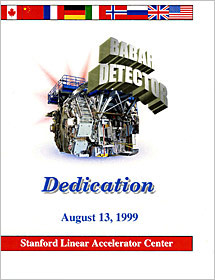
Handy Links
SLAC News Center
SLAC Today
- Subscribe
- Archives: Feb 2006-May 20, 2011
- Archives: May 23, 2011 and later
- Submit Feedback or Story Ideas
- About SLAC Today
SLAC News
Lab News
- Interactions
- Lightsources.org
- ILC NewsLine
- Int'l Science Grid This Week
- Fermilab Today
- Berkeley Lab News
- @brookhaven TODAY
- DOE Pulse
- CERN Courier
- DESY inForm
- US / LHC
SLAC Links
- Emergency
- Safety
- Policy Repository
- Site Entry Form

- Site Maps
- M & O Review
- Computing Status & Calendar
- SLAC Colloquium
- SLACspeak
- SLACspace
- SLAC Logo
- Café Menu
- Flea Market
- Web E-mail
- Marguerite Shuttle
- Discount Commuter Passes
-
Award Reporting Form
- SPIRES
- SciDoc
- Activity Groups
- Library
Stanford
Around the Bay
Happy Ten-year Anniversary, BaBar

Ten years ago today, colleagues from around the world gathered at SLAC to celebrate the new BaBar Detector and the science it would pursue.
In a letter celebrating the dedication, then Secretary of Energy Bill Richardson wrote:
Congratulations to you, the U.S. team, and to our partners from nine different countries on the dedication of the BaBar Detector. You brought this detector into operation on schedule and within budget, an accomplishment that could not have been achieved without the dedication and support of all of the nearly 600 physicists from 85 institutions who collaborated on this endeavor.
The BaBar experiment continues in this spirit of international cooperation, now as a collaboration of 12 nations, with the addition of Israel and India in February and June of this year, respectively. From its location at the collision point of the PEP-II ring, the BaBar Detector has born witness to record-breaking machine performance and prizewinning discoveries probing the fundamental nature of matter and energy.
"At the dedication, I said that we were about to engage in both a hundred-meter dash and a marathon," said Caltech Professor David Hitlin, who was BaBar's first spokesperson. Each finish line promised insights into the differences between matter and antimatter—specifically, matter–antimatter symmetry violations in a characteristic of subatomic particles called charge parity, or CP. "We were striving to be first to make the first statistically significant measurement of a CP-violating quantity in the B meson system (the hundred meter dash) and we would then strive to take the lead in fully understanding the relation of CP violation to the unitarity triangle construction [of particle physics theory], which would truly be a marathon," Hitlin said. "The marathon is now nearly over, and the entire BaBar Collaboration can take pride in having run world-class races."
With more than 400 scientific papers published, supporting more than 300 doctoral dissertations, BaBar has provided insights into fundamental constituents of matter, including light Higgs bosons, and advanced the careers of many promising young scientists. BaBar's precise measurements of CP violation earned mention in the 2008 Nobel Prize in Physics, and a trip to the prize ceremony for Hitlin and fellow BaBar pioneer Jonathan Dorfan. Thesis work with BaBar has earned many PhD students special recognition, including the European Physical Society's Young Particle Physicist Prize to Maurizio Pierini and the Mitsuyoshi Tanaka Dissertation Award to Jed Biesiada and Shahram Rahatlou.
BaBar's successes depended on the extraordinary performance of the PEP-II collider, collaboration members emphasized. "PEP-II delivered record-breaking performance year after year," said Jonathan Dorfan. "The B Factory's success is testament to the exceptional partnership of its sister facilities, BaBar and PEP-II."
Though the BaBar experiment shut down early during the 2008 budget crisis, the detector's nine years of operation and the collaboration's extraordinary effort in the final months created a deluge of data that continues to support a rich flow of discoveries. As many as 100 doctoral thesis projects based on BaBar are ongoing, noted current BaBar Spokesperson François Le Diberder. "This number is in fact very impressive," he said, "since it implies many papers still to come. The completion of most of our scientific programme will need at least three years of intense analysis effort."
Photographs and mementos from the 1999 BaBar Detector dedication are gathered on the SLAC Archives and History Department's BaBar Detector Dedication page.
—Shawne Workman
SLAC Today, August 13, 2009